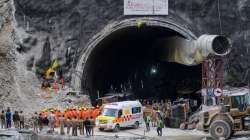In a major development, the 41 workers trapped in the 4.5-kilometer-long Silkyara tunnel in Uttarakhand for 17 days are on the verge of being rescued. The manual drilling team, despite facing challenges in the difficult terrain, is now just meters away from the trapped workers. The nation awaits their safe extraction from the tunnel, a crucial component of the ambitious Char Dham project.
The Char Dham Project and the Silkyara Tunnel
The Silkyara tunnel, a key element of the Centre's Char Dham project, aims to provide all-weather connectivity to four prominent Hindu shrines in Uttarakhand: Badrinath, Kedarnath, Gangotri, and Yamunotri. This 4.5 km-long, double-lane tunnel connects Silkyara and Dandalgaon in Uttarkashi district. Currently under construction, it is expected to reduce travel time by an hour once completed. The project is undertaken by the Hyderabad-based Navayuga Engineering Company Limited.
What led to the crisis?
On November 12, a section of the tunnel, between 205 and 260 meters from the Silkyara side, collapsed, trapping workers beyond the 260-meter mark. Although authorities insist on a detailed investigation, theories circulate about the collapse being linked to a landslide in the fragile Himalayan region. Some experts attribute the incident to hasty development in this ecologically sensitive area.
Potential lapses and controversies
Claims suggest that a blast conducted by the construction teams may have triggered the collapse. According to NDTV, geologist and environmental science professor SP Sati stated, "I am certain that a major blast led to this collapse," emphasising a potential lapse in safety measures. Reports also highlight that the construction plan included an escape tunnel, which was never built. International expert Arnold Dix acknowledged the absence of an escape tunnel, stating it is typically placed at the end due to the expectation that tunnels wouldn't collapse. However, he added a disclaimer about considering geological conditions.
The rescue operation
The manual drilling team, battling the challenging terrain, is now just meters away from reaching the trapped workers. Despite setbacks, the operation is on the brink of success. The nation is anxiously awaiting the safe rescue of these workers, and prayers and hopes are high for a positive outcome.
Conclusion
As the rescue operation approaches a critical phase, the spotlight intensifies on the Char Dham project, its safety measures, and the environmental considerations in the Himalayan region. The incident prompts a reevaluation of construction practices in ecologically sensitive areas and emphasizes the need for stringent safety protocols in ambitious infrastructure projects. The nation remains united in anticipation, hoping for the safe return of the trapped workers from the depths of the Silkyara tunnel.
Also read | Uttarkashi tunnel collapse: From rat-hole mining to vertical drilling, methods used to rescue 41 workers
